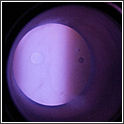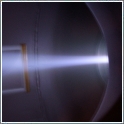Helicon Radiofrequency Plasma Thrusters

High-density plasma is produced by the use of a helical radio frequency antenna to ionise neutral gas in a tube closed at one end. The helical antenna excites the gas to dissociate electrons and generate highly energetic ions.
The Helicon source is a device capable of high-efficiency plasma generation. High-density plasma is produced by the use of a helical radio frequency antenna to ionise neutral gas (e.g. argon, krypton, xenon, helium or hydrogen) in a tube closed at one end. The helical antenna excites the gas to dissociate electrons and generate highly energetic ions. Solenoid coils surrounding the tube create a magnetic field inside to confine the plasma within the tube and reach a high ion particle density.
The plasma can be heated to very high temperature by another antenna downstream (operating at the Ion-Cyclotron Resonance Frequency) and expanded through a "magnetic nozzle" into vacuum thus producing a moderate thrust and a high specific impulse, as in the case of the VASIMR thruster developed by NASA [1]. Alternatively plasma can be accelerated to supersonic speeds by being forced through an electric double layer (a magneto-shock region with sudden drop in potential) created by a rapidly expanding magnetic field very close to the open end of the tube, as in the Helicon Double Layer Thruster developed by the Australian National University [2]. Other methods such as a pulsed induction coil to generate an accelerating induced current sheet may also be used to obtain thrust, as in the Faraday Accelerator at Princeton University.
These helicon-type thruster concepts are entirely scaleable to high power (kW to MW) operations in order to potentially obtain much higher thrust levels (order of N) and even higher specific impulses (order of 10,000s or more), with the additional advantage of requiring no high-current cathode, acceleration grids or neutraliser that presently limit the operating lifetime in other electric thrusters. However, the scaling to high power is a challenging task since non-linear interactions between plasma flow, magnetic and electric fields at higher energies are difficult to predict and small-scale instabilities arising may cause a reduction in thrust efficiency. Nonetheless, some estimates of design scaling and performance are needed in order to gauge their potential for various space applications. Following this first step, detailed simulation modelling and experimental research progrust be conducted to optimise thruster geometry, radio frequency systeams mm and applied magnetic field for high-energy plasma generation efficiency, confinement and acceleration.
Despite the significant challenges to be overcome, in principle the potential for helicon-type thrusters operating at high power levels to produce a high continuous thrust and high, variable specific impulse (compared to some other types of electric propulsion) make them an attractive choice for propelling large spacecraft requiring high delta-V and acceptable transfer times. These missions include human or cargo missions to Mars [3], and robotic missions with large science payloads to orbit planets in the outer solar system [4] or even to deflect near-Earth asteroids [5,6].
The ACT is studying two different plasma thruster concepts, the RF Helicon Thruster (experimental and modelling studies) and the Helicon Ion Cyclotron Resonance Thruster (modelling and preliminary design studies).
RF Helicon Thruster

This study is the result of a joint research effort between the Advanced Concepts Team and Padova University to investigate the formationof double layers.
Double-layers (DLs) are electrostatic structures able to support a potential jump in a narrow spatial region of plasmas. DLs have been studied intensively, interpreting and reproducing magnetospheric, solar and extragalactic plasma phenomena. Current free helicon double layers originating from electropositive and electronegative gases in radiofrequency helicon thrusters have been obtained during experimental tests by several research teams around the world. The experimental evidence of the double layer envisages tantalizing performance of a thruster exploiting this effect.
The study performs a deep numerical investigation on Double layer formation, stability and characteristic and explores the applicability of this concept to space missions.
The following phenomena have been reproduced and studied numerically:
- The propagation, absorption and mode conversion of all relevant waves in the plasma
- How much plasma is produced, and at what plasma temperature, for a given amount of power absorption
- The thruster specific impulse and thrust with a given plasma source
Helicon waves were systematically compared and launched with different axial and azimuthal mode numbers to find the one that gives optimal power absorption, and which input power to the antenna is needed to achieve a specified specific impulse and thrust. With the optimal mode numbers identified, an antenna can be designed that excites the desired mode. A Preliminary design of a low Power RF helicon truster was performed.
The outcome of the Ariadna Study ''Numerical Simulation of the Helicon Double Layer Thruster Concept'' led to a successful project proposal to the European Commission (HPH.com). The contract has been awarded to the consortium lead by the University of Padova.
Helicon Ion Cyclotron Resonance Thruster
References
[1] J.P. Squire, F.R.C. Diaz, T.W. Glover, V.T. Jacobson, D.G. Chavers, R.D. Bengtson, E.A. Bering, R.W. Boswell, R.H. Goulding And M. Light, "Progress in experimental research of the VASIMR engine". Fusion Science and Technology 43, 111-117 (2003).
[2] C. Charles, R.W. Boswell, "Laboratory evidence of a supersonic ion beam generated by a current-free "helicon" double-layer". Phys. Plasmas 11, 1706-1714 2004.
[3] Future Power System for Space Exploration*, S54 study, ESA publication, February 2002.
[4] Report of the NASA Science Definition Team for the Jupiter Icy Moons Orbiter (JIMO)
[5] Williams, B.G., Durda, D.D., Scheeres, D., The B612 Mission Design, 1st AIAA Planetary Defense Conference, Orange County, California, 2004.
[6] Walker, R., Izzo, D., de Negueruela, C., Summerer, L., Ayre, M., Vasile, M., Concepts for Near Earth Asteroid Deflection using Spacecraft with Advanced Nuclear and Solar Electric Propulsion Systems, paper IAC-04-Q.5.08, 55th International Astronautical Congress, Vancouver, Canada, October 2004.